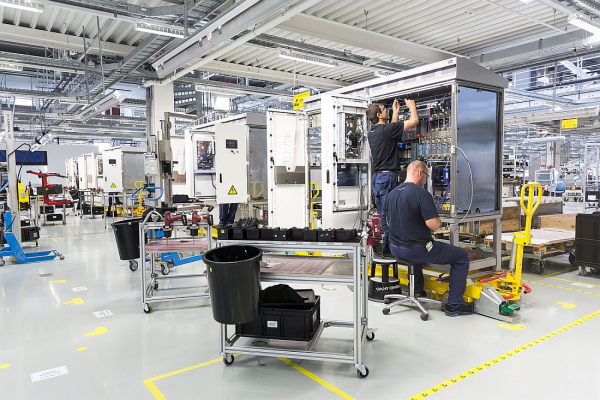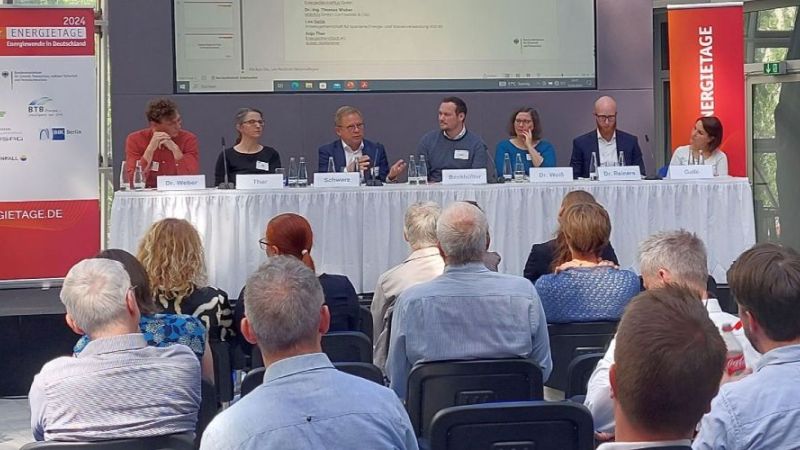 © SMA
© SMA
Photovoltaics
Stabilising the power grid with photovoltaic power plants
Two thirds of all new photovoltaic systems worldwide are large solar power plants with outputs of up to 500 megawatts. The aim of the joint project is to prepare a new generation of large-scale photovoltaic systems technologically so that they can take over the supply security and system stability in the power grid in the future. This is intended to significantly improve the economic operation of the power plants and also further reduce the cost of solar power. Contributing elements include innovative semiconductor components, adapted power electronics and optimised system concepts with new control systems and batteries integrated directly into the power plant.
Photovoltaic power plants will take over grid-friendly tasks in the future
The newly installed output of large solar power plants worldwide now amounts to more than 80 gigawatts per year, with a continuing upward trend. Large-scale photovoltaic power plants increasingly have to take over grid system services because of the often considerable share of solar power in the interconnected power system. They must therefore contribute to balancing out fluctuations between supply and demand, for example, and stabilise the power grid by taking on the necessary functions. These tasks are currently performed by conventional power plants, which will no longer exist in the future. Photovoltaics will then serve as a fundamental pillar in the power grid and must be able to completely fulfil all the grid-friendly tasks of a power plant. At the same time, the cost of solar power must be further reduced. This requires a technologically advanced generation of photovoltaic power plants, without making power plants and network operation more expensive. This is where the PV Power Plant 2025 research project comes in, short for "Innovations for the next generation of PV power plants: New components, system solutions and inverters for a cost-effective and grid-friendly electricity provision". The aim of the project is to establish photovoltaics as a sustainable, reliable, crisis-proof and cost-effective power supply technology. Investigations are being carried out into inverter technologies and intelligent system solutions specially tailored to these tasks. This includes novel and adapted power plant components, control and regulation systems and innovative semiconductor components for power electronics. In addition, modern design methods and solutions for power electronics are needed that enable the use of additional system components, such as energy storage units.
New system concept with integrated energy storage system
The solar power plant can be better integrated into the supply network by using small battery storage systems installed directly in the power plant. To ensure that they work particularly efficiently, the battery storage systems are coupled to the inverter on the DC side, meaning parallel to the solar modules. The researchers developed a battery power converter for this purpose that has a good efficiency of 99 per cent. The system concept with battery power converter for large-scale photovoltaic power plants enables grid-friendly, reliable and cost-efficient operation.
New unit concept enables flexibility and new functions
A completely redesigned device concept was developed for future photovoltaic and battery inverters. Its modularity makes the scalable system suitable for different multi-megawatt performance classes as well as functionalities, such as for reactive power management, balancing energy, instantaneous reserve and grid support, all the way to stand-alone operation and reconstruction of the grid. It can be used worldwide. The scientists achieved this success through many continuously accomplished advances in the project, such as in the field of power electronics and semiconductor devices.
New materials improve power electronics
A special focus of the industry project teams was on the topic of semiconductor components. These are used in power electronics so that high electrical currents and voltages can be controlled and switched safely and efficiently. To improve the power electronics, the researchers developed new semiconductor components and modules. Silicon carbide components were also used, which are currently more expensive than pure silicon semiconductors, but offer various systemic advantages. Silicon carbide has different material properties than silicon. The semiconductor is more efficient and switches faster at higher frequencies. This reduces cooling and material costs. Additional advantages include reduced material consumption due to the use of smaller magnetic components.
The project teams constructed the power electronics, meaning the centrepiece of the inverter, with silicon carbide components on a laboratory scale and were able to test them successfully. In the end, the new power electronics proved to be fit for purpose.
Controlling power plants to serve the grid
In the future, a universally applicable "Power Plant Manager" will take over the control system and regulation of the entire solar power plant, including the required grid system services at the grid connection point. This is the interface to the network operator's supply network. The scientists optimised the electronic unit as a functional prototype solution suitable for practical use. This monitors and maintains the power plant behaviour. This enables grid-friendly and economically improved operation of the photovoltaic or storage power plant. The control and regulation unit that was developed and successively expanded with further functionalities can be adapted to the respective technological, economic and political framework conditions. This also includes the many tasks of ensuring a stable power grid.
New solar inverters and semiconductor components for series production
The industrial partners involved plan to transfer the results achieved into series products and to market them. On the part of SMA Solar Technology, this includes innovative solar and battery inverters in the megawatt class and the hundred kilowatt class, but also control systems for photovoltaic power plants. Infineon and Danfoss also aim to manufacture and market the developed semiconductor devices and power modules. The solar inverters and system technology components can be used worldwide, especially in large-scale photovoltaic power plants. The results from the PV Power Plant 2025 project are additionally also to be made available to other sectors. For example, the findings on new components and power electronics are interesting for the automotive industry, for the construction of electric vehicles, as well as for electrolysis converters. These are needed to supply electricity for the hydrogen electrolysis. This method produces hydrogen by splitting water into its constituents hydrogen and oxygen.














